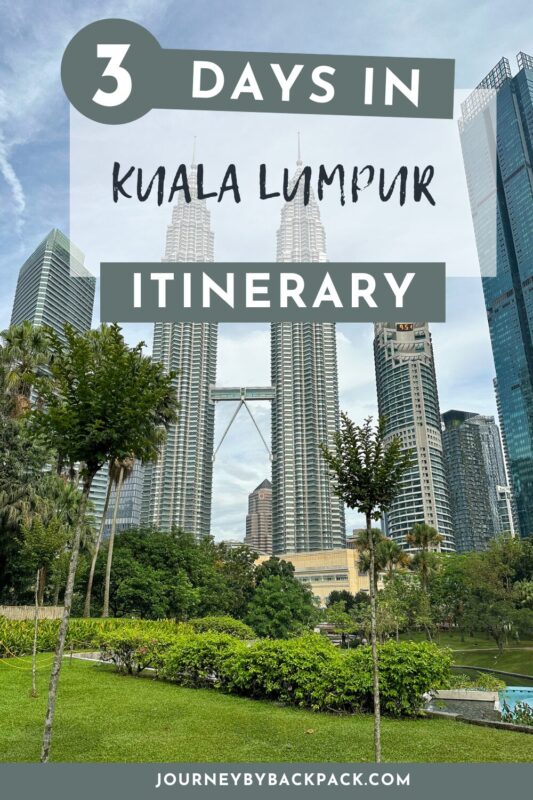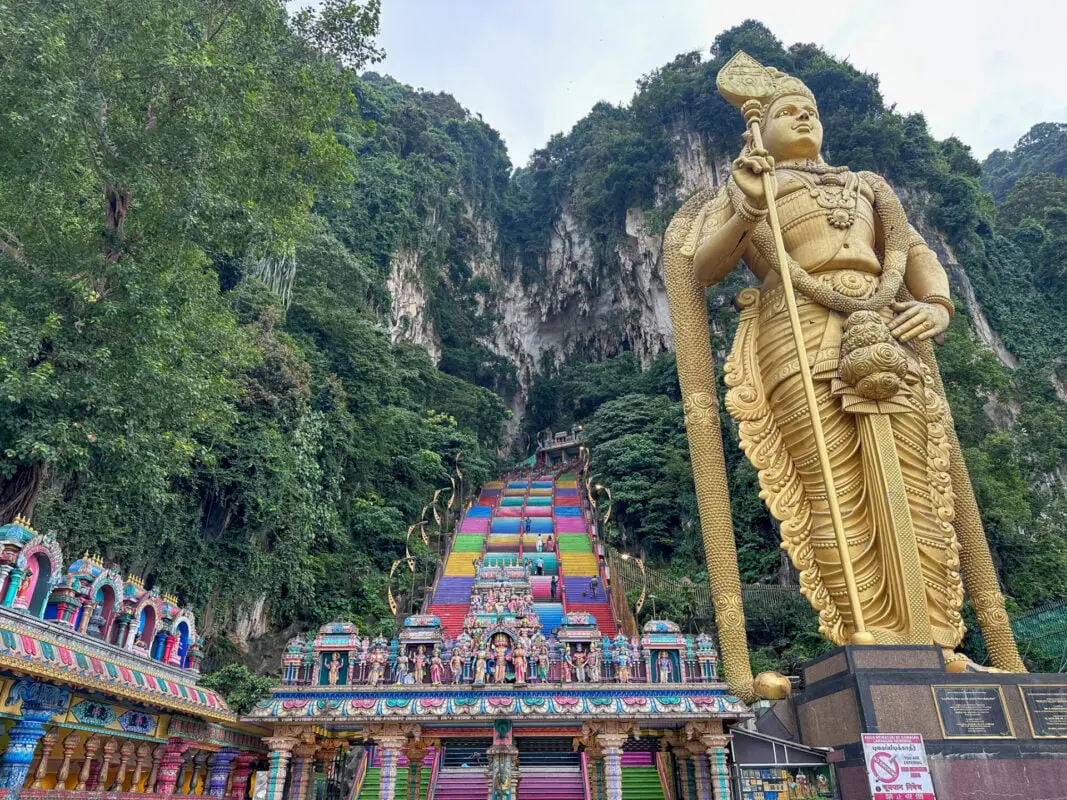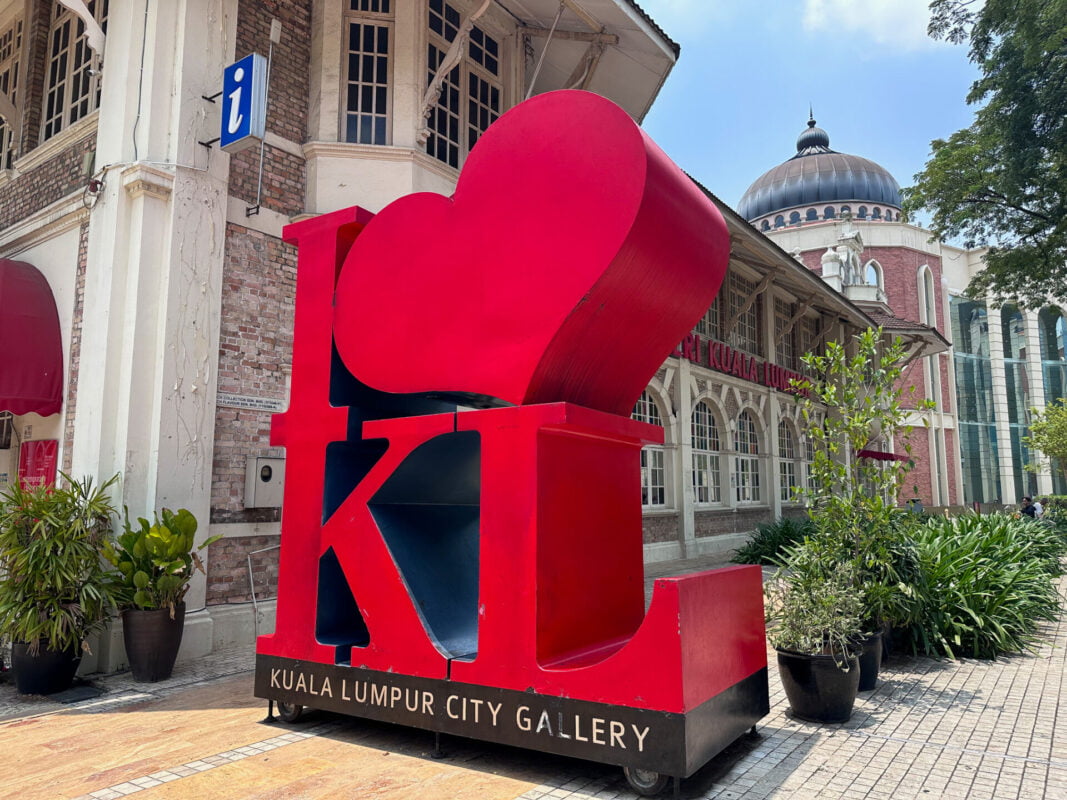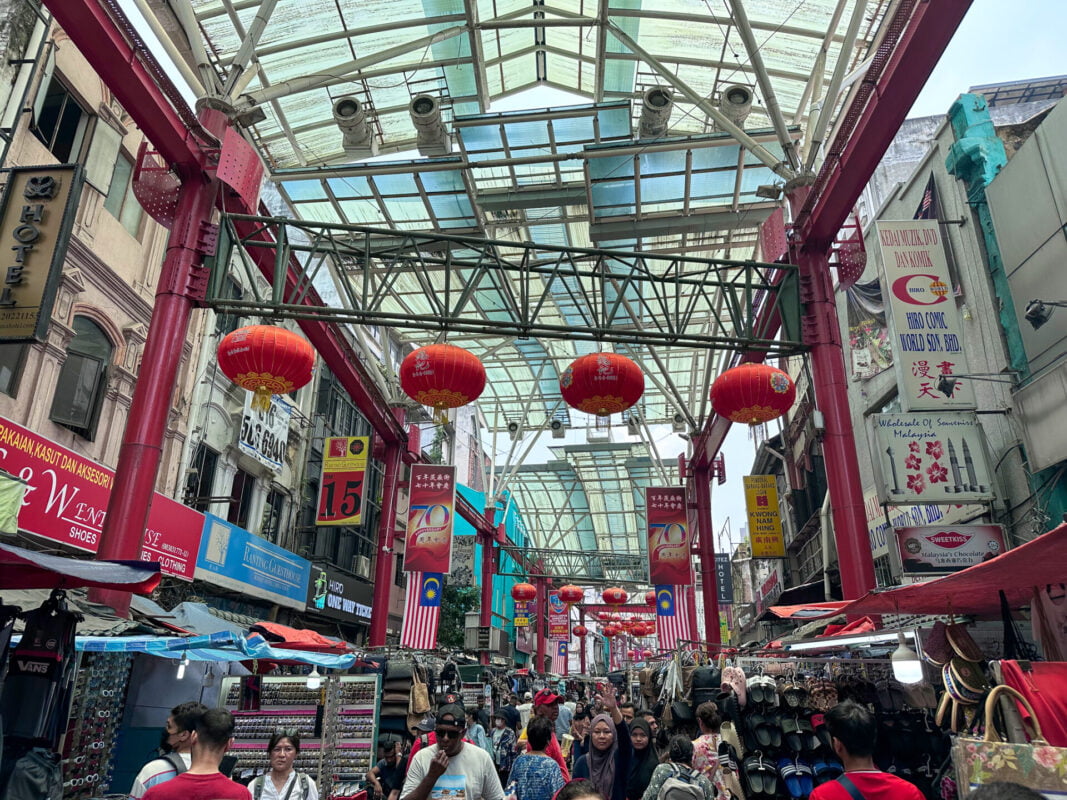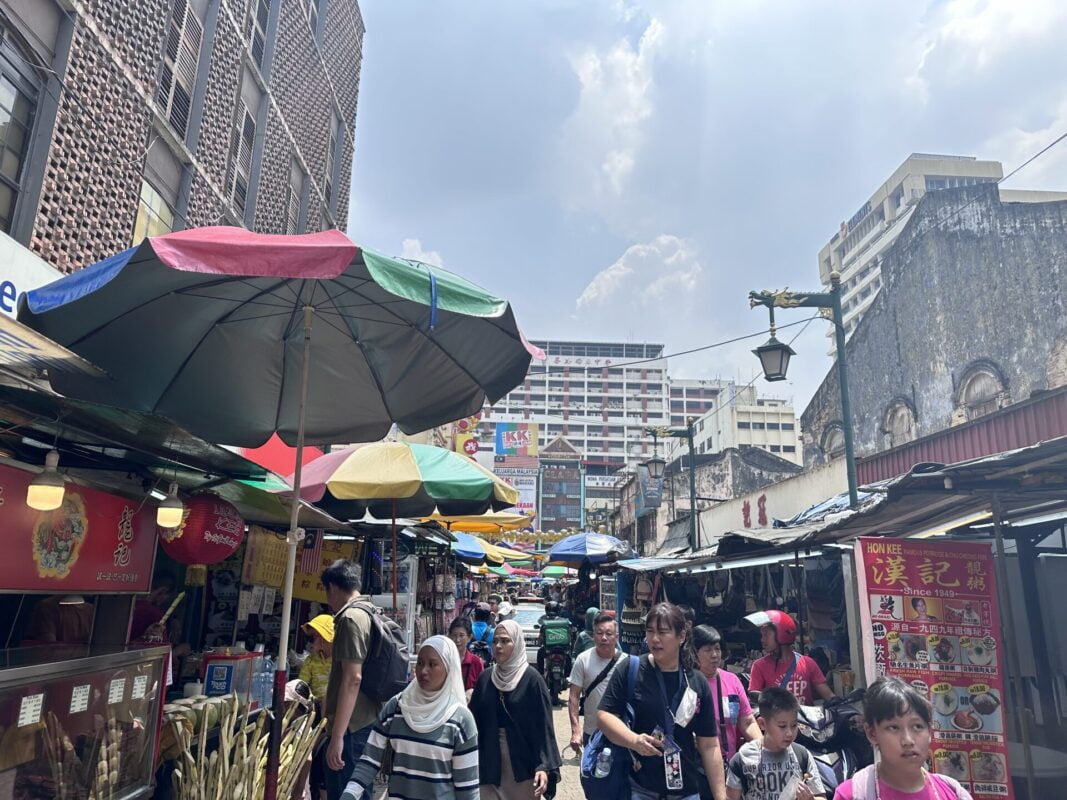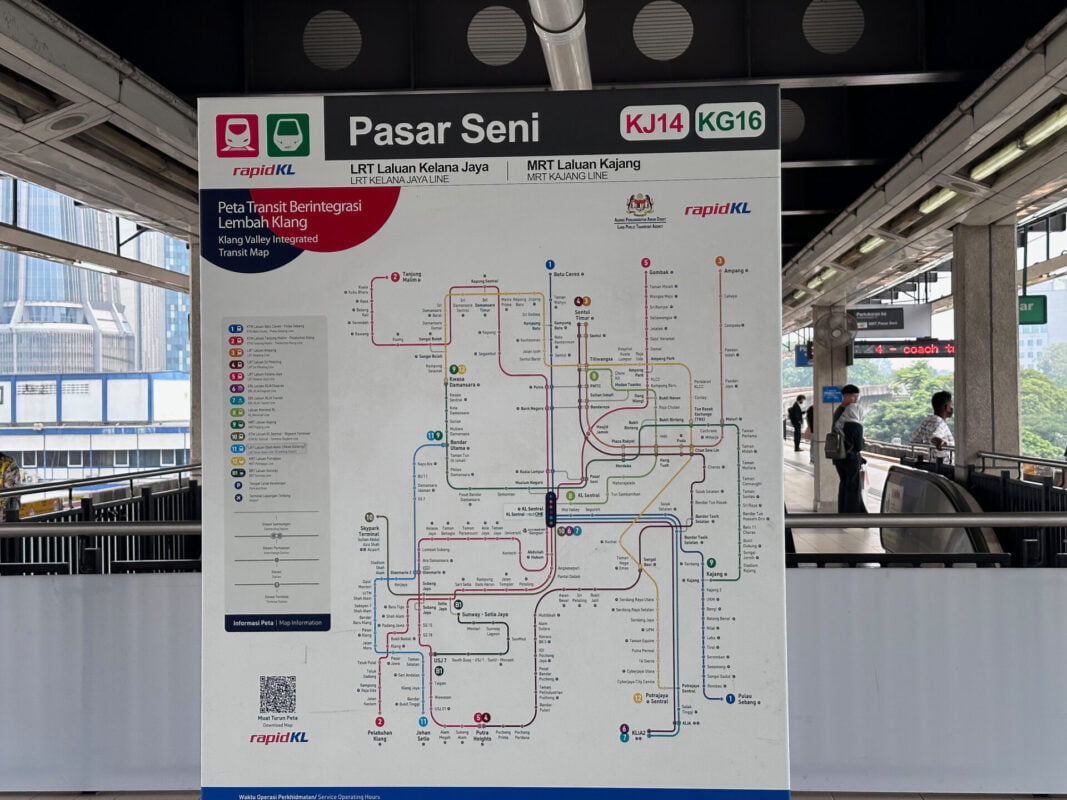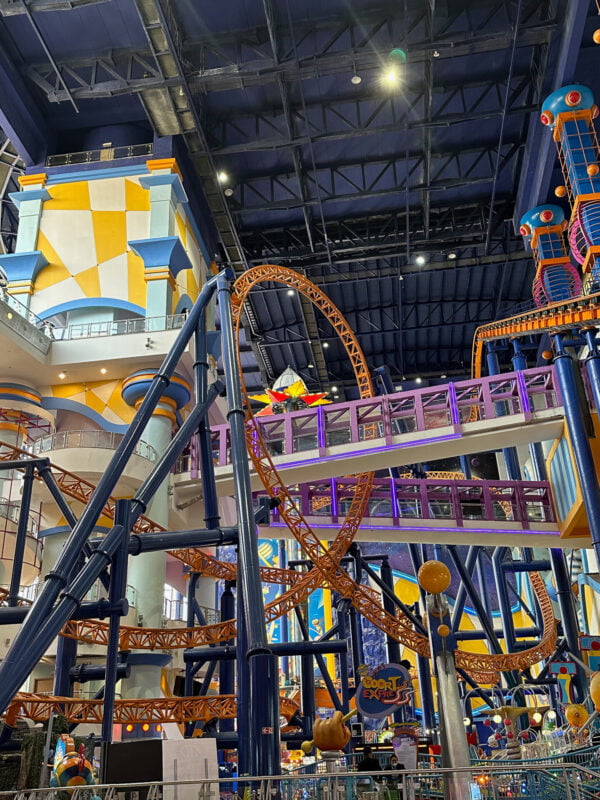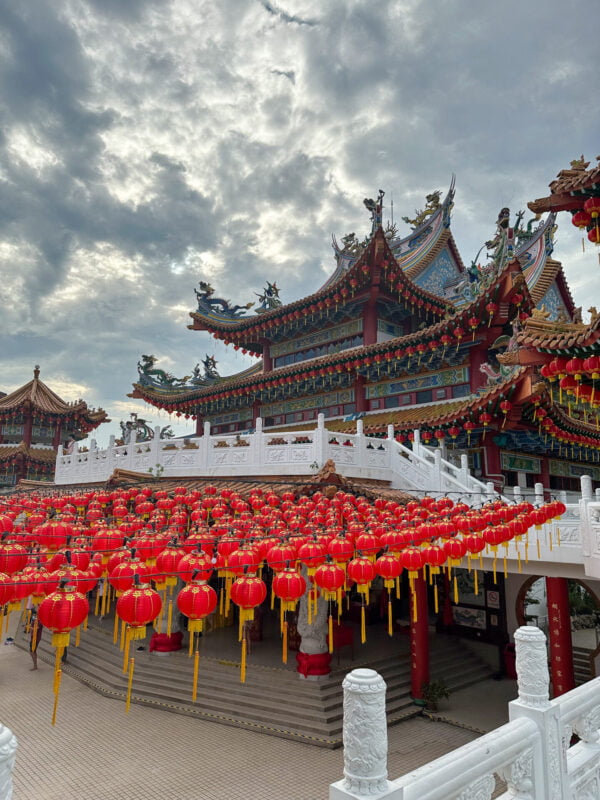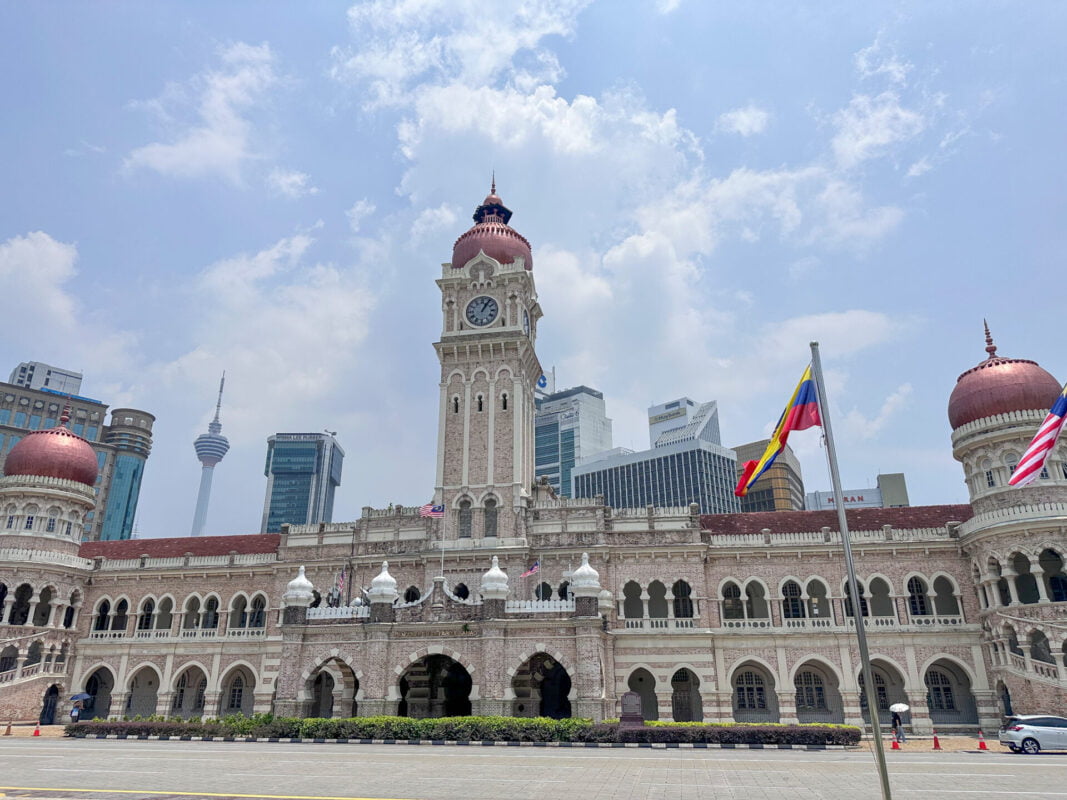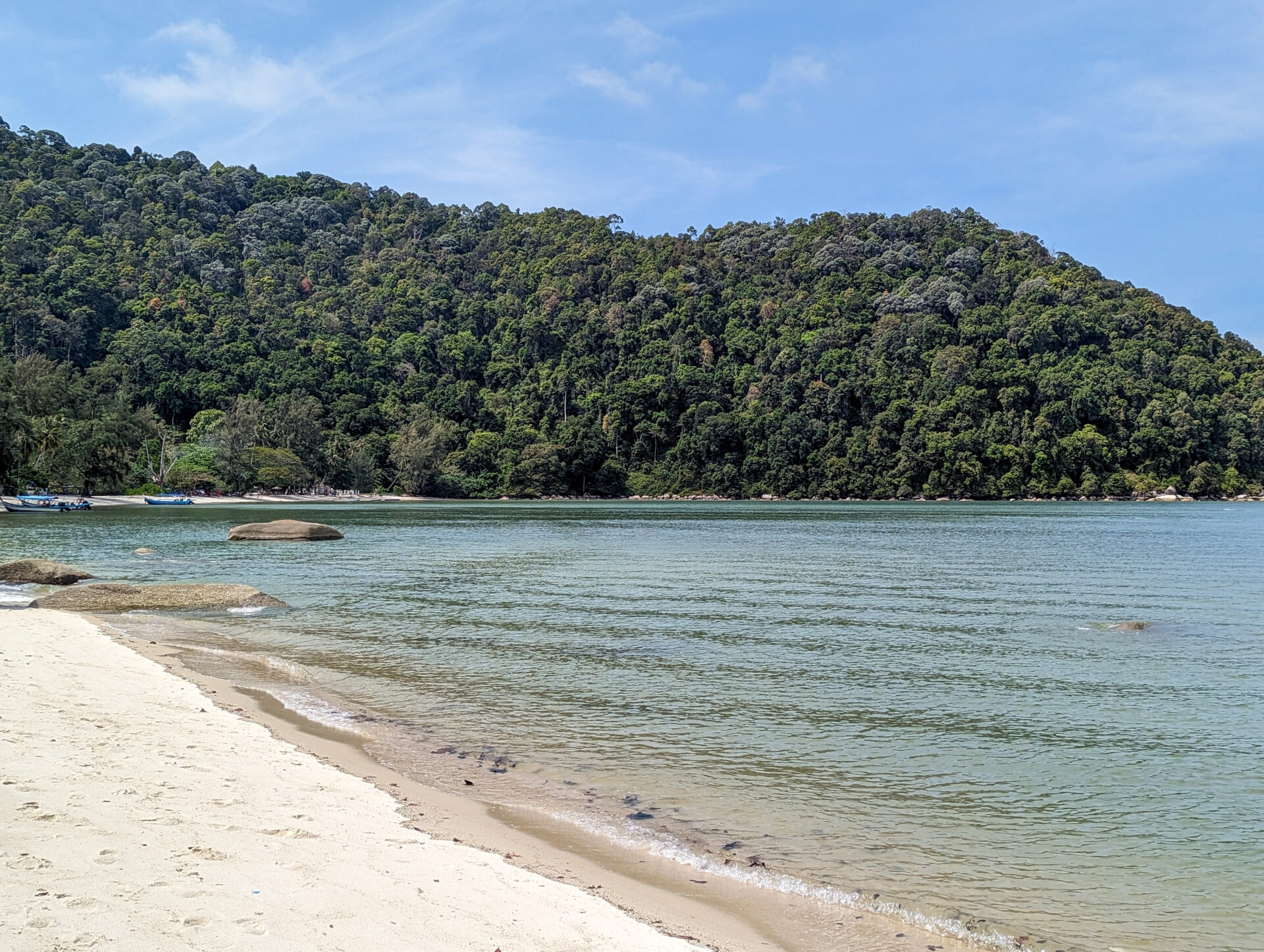Kuala Lumpur is one of Southeast Asia’s major cities, yet it’s often overlooked by backpackers (as is Malaysia as a whole). I’ve visited Kuala Lumpur three times myself now, and it’s become one of my favourite cities in Asia. Here, you’ll find a 3-day itinerary for Kuala Lumpur, perfect for first timers.
Kuala Lumpur is one of the most diverse cities I’ve ever visited. It’s where different religions and cultures have come together. A walk down a street can take you past a Hindu temple, a Mosque, and a modern shopping mall, all within a few minutes. It’s modern yet has centuries of history. I’ve never visited anywhere else like it.
In this post, you’ll find the perfect 3-day itinerary, ideal for first timers and suitable for backpackers and regular visitors alike.
I love Kuala Lumpur, but Malaysia is a fantastic country to explore. Consider getting away from the city and visiting some other highlights such as the Cameron Highlands and Penang. Here’s a backpacking guide and itinerary for Malaysia.
How long to spend in Kuala Lumpur?
For most people, three days in Kuala Lumpur is enough time to see what the city has to offer.
If you’re short on time, spending two days in Kuala Lumpur is still a reasonable amount of time to get a feel for the city and see the highlights.
Kuala Lumpur is also a good base if you want to stay put for a while and have access to everything you need.
Only have one week in Malaysia? Here’s the perfect 7 day Malaysia itinerary.
Where to stay in Kuala Lumpur?
There are a few options when it comes to choosing where to stay in Kuala Lumpur. Thankfully, getting around Kuala Lumpur is relatively easy and in-expensive, meaning you don’t need to think too hard about where to stay.
KLCC
Many people opt to stay near the Petronas Towers. This is one of the most modern areas of the city, but there are still plenty of local eateries and shops. It’s within walking distance from many of the attractions including the famous Petronas Towers and shopping malls. If you want a modern-feeling neighbourhood with everything on your doorstep, this is the place.
Bukit Bintang
This is one of the most popular areas to stay in Kuala Lumpur. It’s right in the heart of the action with the iconic shopping mall, Pavilion, and the famous Jalan Alor Street Food Market being right on its doorstep.
I personally think this is the best place to stay in Kuala Lumpur. It’s where the old meets the new, and everything you need is close by. You’ll get real feel for this modern bustling city whilst still being able to embrace its culture and history.
It’s a brilliant place to base yourself.
Chinatown
Chinatown is right in the hustle and bustle of Kuala Lumpur. It’s an explosion on the senses and a chaotic but fascinating experience. Staying here won’t be for everyone, it’s noisy and difficult to escape the crowds. But it offers an authentic experience and puts you close to some delicious street food.
I stayed at Mingle Hostel in Chinatown for four nights. I loved staying in this area, but it’s worth noting it’s quite a walk to some of the highlights, including the Petronas Towers, so consider this when deciding where to stay.
Is Kuala Lumpur safe for solo female travellers?
Kuala Lumpur is a safe city, including for solo female travellers. I spent five days there as a solo female and never once felt unsafe.
Kuala Lumpur is still a major city, and as with all big cities, there’s always a risk of crime. While petty crimes aren’t as common in Kuala Lumpur, it’s still important to make sure your belongings are always secured. Another piece of advice for big cities is not to walk around alone at night. The tourist areas such as the Petronas Towers are often very crowded at night, so these areas are normally fine. But I wouldn’t recommend walking off down any quiet streets by yourself.
Best time of year to visit Kuala Lumpur
Kuala Lumpur is hot and humid throughout the year. The dry season is traditionally between May and September, and this is considered the ‘best’ time of year to visit when it comes to the weather.
Rain can hit Kuala Lumpur at any time of the year, however. I visited in September and we had a rainstorm every single day. The rain tends to pass very quickly though, so don’t let this put you off.
With rain possible all year round, I wouldn’t let the weather influence your decision on when to visit too much.
One of the best times of the year to visit Kuala Lumpur is for the Lunar New Year. Hundreds of thousands of people from all over Asia head to Kuala Lumpur for the celebrations. There are fireworks galore and the malls are decorated to the max with stunning displays. The only downside of visiting for Lunar New Year is the crowds. My first experience in Kuala Lumpur was for Lunar New Year, and I just assumed it was always that busy. When I returned a few months later I couldn’t believe the difference. You’ll also find prices will be higher around the Lunar New Year dates.
How to get to Kuala Lumpur from the airport
The easiest way to get from Kuala Lumpur Airport to the city is to use Grab – an app like Uber. Download the app and have everything set-up before your arrival to make the process as smooth as possible. When booking your Grab ride, the app will tell you exactly where to wait.
Grab is relatively inexpensive in Kuala Lumpur, with a Grab Taxi from the airport to the city costing around 60 MYR ($13 USD).
The other option is to get the KLIA Express to the main train station in Kuala Lumpur (KL Sentral). A ticket on this will cost you 55 MYR ($11.50 USD). This isn’t much of a cost saving compared to a grab, and once you’re in the city, you’ll likely need to get a Grab to your accommodation anyway.
When I was staying near KLCC, I worked out getting to the airport using the KLIA Express train would cost me more than just booking a Grab.
Best food in Kuala Lumpur
Malaysian food is some of the most delicious food in the world. It’s a culinary implosion of different cultures and there’s something for everyone to enjoy. Here are some of the best spots to eat in Kuala Lumpur.
Jalan Alor Street Food
This is one of the most popular and famous street food markets in Kuala Lumpur. The hawkers start selling from food from 5pm. You’ll find everything from bao buns, to noodles, to BBQ beef jerky and fish.
To get the most out of your visit to Jalan Alor Market, consider joining a guided tour.
Chinatown
Another popular street food market is in Chinatown where you can get traditional Chinese-Malaysian food. A stroll down the street will get the senses tingling with an endless amount of choices.
Chinatown has had a bit of a revamp in the past couple of years, and you’ll also find lots of Instagram-worthy restaurants here. One of my favourites is Leaf&Co, which is under the Mingle Chinatown Hostel.
Here’s some of the best things to eat in Kuala Lumpur’s Chinatown.
Lot 10 Food Court
Arguably the best food court in Kuala Lumpur, Lot 10 is a fantastic place to grab a bite to eat. There are plenty of food stalls to choose from serving delicious Malaysian food, as well as foods from all over Asia, including Japanese and Korean.
Suria Mall Food Court
If you want something a little less intimidating, consider the Suria Mall food court in the Petronas Towers. There are plenty of options here, including Malaysian, Korean and Western. It’s not quite as chaotic as Lot 10 and much more chilled.
How to get around Kuala Lumpur
Kuala Lumpur is a big city and a lot of the attractions in the below itinerary are spread out. While some of the key spots are within walking distance from each other, you’ll likely find yourself needing to use Grab or Kuala Lumpur’s MTR (Metro) system.
Walk
A lot of the highlights are within walking distance from each other, such as the Petronas Towers and the Pavilion Mall. When I was staying in Chinatown, I also walked to the centre from here.
Be aware Kuala Lumpur is hot and humid, which can make longer walks uncomfortable. Thankfully, most of the shops and cafes have strong air conditioning, so it’s easy to escape the heat.
If you don’t have a Malaysian Sim Card, be sure to download a map of Kuala Lumpur offline in Google Maps. This means you can find your way around even without mobile service.
Grab
Grab is similar to Uber and operates across most of Asia. It’s often the most convenient way to get around Kuala Lumpur, particularly when visiting spots out of the centre, such as the famous Batu Caves. The best part about Grab in Malaysia is that it’s a lot cheaper than the likes of Uber in the bigger Western Cities. A 30-minute Grab ride often costs less than $5 USD making it a great way to get around.
The only catch with Grab in Kuala Lumpur is that the chaotic traffic can often delay drivers. If you’re in the city centre or Chinatown during rush hour, you may need to wait a significant amount of time for your Grab to arrive.
Kuala Lumpur Metro System (MTR)
Kuala Lumpur has a good Metro and Monorail network which can often help you to get to where you want to be. It’s very cheap and relatively straightforward to use.
The best way to navigate the network is to put your destination into Google Maps and look at the public transport options. You can purchase your ticket at machines inside the stations. It’s important to have small change/notes to pay for your ticket. Most machines won’t accept anything bigger than a 5 or 10 MYR note.
Once you’ve paid for your journey, you’ll be given a token which you tap on the entry barrier. When you arrive at your final stop, put the token into the slot at the exit barrier. Don’t lose the token during your journey, otherwise you’ll have no proof you’ve paid.
Kuala Lumpur itinerary: day 1
Today is going to be a bit of a city centre highlights tour. Use today to orientate yourself and get a feel for this amazing city.
Stop one: KLCC Park
Begin your day at the famous KLCC Park. Spend some time going for a stroll and getting some epic photos of the iconic Petronas Twin Towers. This is one of the best spots to see the twin towers in their full glory.
Stop two: Petronas Twin Towers (opt to go up)
After admiring the towers from afar, head inside (or even up) the towers. Inside, you’ll find the Suria Mall which is a popular shopping destination full of designer and high street brands. If you want to see this magnificent city from above, there is the option to go up the towers to the viewpoint.
It’s recommended to book your ticket to the viewpoint in advance as it can sell-out.
Stop three: KL Forest Eco Park or Menara Kuala Lumpur Tower
Next, you have a couple of options (or attempt to do both if you’re feeling energetic.)
First up is the Kuala Lumpur Forest Eco Park. Before Kuala Lumpur was a city, the area was covered in lush, green rainforest. The KL Forest Eco Park is home to some of this native vegetation. Inside, you can walk on the nature trails and a canopy trail. It costs visitors 40 MYR ($9 USD) to enter.
If you’re not exploring Malaysian nature anywhere else in the country, this is well worth doing.
The other option is to head up the Menara KL Tower (or try to do both). The tower has a 360-degree observation desk offering panoramic views of the city. There’s an outdoor deck, as well as a ‘see-through floor’ box for those who are brave enough. Be sure to book your tickets in advance.
Stop four: Lot 10 Food Court
After an adventurous morning, head to the Lot 10 Mall’s food court. There are plenty of vendors here selling traditional Malaysian foods, as well as delicious dishes from all over Asia. It can be a little chaotic inside, but that’s part of the fun.
Stop Five: Mall hop (Pavilion and Berjaya Times Square)
Kuala Lumpur is famous for its world-class shopping malls. Even if shopping isn’t on your agenda, a stroll round the iconic malls is still a memorable experience. The size of these malls is something else.
First up is the Pavilion Shopping Mall. The mall is home to over 700 shops and is in the popular Bukit Bintang district. You could spend hours getting lost in this mall, but there’s another epic mall on the itinerary – Berjaya Times Square. This mall is an entertainment hot spot, and even has an indoor theme park including a rollercoaster. Yes, you read that right – a mall with an indoor rollercoaster.
Stop six: Street food and street art
End your first day in Kuala Lumpur by trying some delicious street food. Either join a street food tour, or head to the Jalan Alor Street Food night market.
The street is full of hawkers selling authentic street food which gets the senses tingling. I used to be nervous about trying street food, but I’ve learnt it’s one of the best ways to experience a different culture. Don’t be afraid to ask a local what they would recommend.
Before grabbing a bite to eat, check out the local street art in the surrounding streets.
Day 1 transport
Once you’ve arrived at your first spot, you should find it easy enough to walk between all the stops on today’s itinerary. You may wish to take a Grab (the Asian version of Uber) between the towers and your next stop, but it is walkable.
Kuala Lumpur itinerary: day 2
Today’s exciting itinerary takes you away from the modern centre of Kuala Lumpur and will allow you to learn more about the culture in Malaysia. The day also gives a real insight into just how multi-cultural Kuala Lumpur is, with visits to Hindu, Islamic and Buddhist points of interest.
Stop one: Batu Caves
Arguably one of the top highlights of visiting Kuala Lumpur, a trip to the Batu Caves in an absolute must. The Batu Caves are home to a Hindu temple and shrine. It attracts hundreds of tourists and worshippers every single day.
The main attraction of the caves for tourists is the 272 colourful steps which lead you up to Sri Subramaniya Swamy Temple.
Entry is free, but you can opt to pay a fee to enter some of the smaller caves on guided tours if you please.
Batu Caves has its own MTR Station – take the KTM Komuter train from KL Sentral to reach the caves. Getting a Grab from the centre of Kuala Lumpur is also relatively inexpensive and often more convenient.
With the Batu Caves being so popular, I suggest getting there as early as you can. The caves open at 7am so arrive for then. It gives you the best chance of seeing the rainbow steps without the crowds.
Important note: women are required to have their knees and shoulders covered when visiting the Batu Caves. There are sarongs available to rent at the Batu Caves.
Stop two: Wilayah Mosque
The Wilayah Mosque (or Federal Territory Mosque) boasts some stunning Islamic architecture. It’s arguably one of the best mosques to visit in all of Kuala Lumpur. It’s beautiful and gives you firsthand insight into the Islamic Culture. There are free tours running throughout the day.
You can jump in a Grab to get here from the Batu caves.
Stop three: Thean Hou Temple
Next up is a stop at the Thean Hou Temple. This is one of the largest and oldest Buddhist temples in all Southeast Asia. Having already visited a Hindu temple and a mosque today, a stop at the Thean Hou Temple allows you to gain insight into yet another major religion in Malaysia.
The temple itself is a stunning example of architecture, and there are endless rooms and shrines to explore.
The temple can get quite crowded and there is often lots of weddings taking place, but it’s well worth the visit.
As above, the easiest way to get here is to jump in a cab from the Wilayah Mosque.
Stop four: Little India Brickfields
Just down the road from the Thean Hou Temple is Little India Brickfields. This is also where the KL Sentral Station is making it a convenient stop before heading back into the city.
Little India Brickfields is a hub of colourful buildings, jewellery, flower shops and local eateries. It’s the perfect way to end your sightseeing for the day.
Stop six: Heli Lounge or a rooftop bar
Seeing Kuala Lumpur from above at night is a wonderful experience, and something everyone who is visiting Kuala Lumpur should do.
Kuala Lumpur has no end of rooftop bars and pools. One of my favourites is Heli Lounge. The spot is a helicopter landing point by day, and a bar at night. It’ll cost you 100 MYR ($21 USD) to enter (Aug 23), but this includes two free alcoholic drinks from a set list. It sounds pricey, but you won’t find much better in Kuala Lumpur.
If the weather isn’t favourable, you can sit inside the main bar and go up to the helipad to take photos when it clears. We went to the bar to catch the sunset and thought we’d be kicked out for being dressed too casually, but they didn’t seem to care and we ended up staying till late.
Day 2 transport
Today, you’ll need to familiarise yourself with the public transport system or opt to take a Grab taxi. Grabs are relatively in-expensive in Kuala Lumpur and often the easiest method to get around. I got a Grab from KLCC to Batu Caves for less than $3 USD.
From Little India, it’s easy to jump on the MTR Rail System and get back into the city center. Google Maps is a great way to navigate around Kuala Lumpur.
Kuala Lumpur itinerary: day 3
Today’s itinerary takes you out of the city centre to the Botanic Gardens, followed by visiting the bustling Chinatown and famous Merdeka Square.
Stop one: Perdana Botanic Gardens
Start your day at the Perdana Botanic Gardens. Take a stroll around the peaceful gardens and get some fantastic views of the city. Entry is free, but certain exhibits such as the butterfly garden cost money to enter.
Stop two: National Mosque of Malaysia (Masjid Negara)
A short walk from the Botanic Gardens is the National Mosque of Malaysia. The Mosque was built back in 1963 to celebrate Malaysia’s independence. The giant structure can hold 15,000 people and is surrounded by beautiful gardens.
The mosque is open for visitors from 9am to 12pm and 3-4pm. However, there was mixed information about the opening hours, so it’s worth checking before you go in case this has changed.
If interested, the Islamic Arts Museum is very close to the Mosque.
Stop three: Merdeka Square
Walk to over to the Muzium Negara MTR stop and head to Pasar Senai station. From there, it’s a ten-minute walk to the historic Merdeka Square, the home of Malaysian Independence.
Admire the Sultan Abdul Samad Building, a highlight of the area (and get a photo besides the famous KL sign).
Stop four: Kuala Lumpur City Gallery
For those interested, the Kuala Lumpur City Gallery is right next door. It contains information about the history of Kuala Lumpur, and shares stories through photos and prints. It costs 10 MYR ($2 USD) to enter.
Stop five: Chinatown and Petaling Street Marker (Consider a food tour)
Spend the rest of the day walking the streets of the chaotic but mesmerising Chinatown. Shop for a bargain or try some tasty street food. There are plenty of local eateries, hawkers, and restaurants where you can grab dinner.
You can also do a street food tour here – I joined A Chef’s Tour – it was a brilliant experience.
PS: on your way from Merdeka Square to Chinatown, be sure to stop at the viewing point for ‘The River of Life’. This iconic spot is the convergence of two rivers and is part of a restoration programme to clean up the river and the surrounding area.
Stop seven: Sri Maha Temple
While in the area, make a quick stop at the Sri Maha Temple. This is a beautiful Hindu temple, and the oldest Hindu temple in Kuala Lumpur.
You can admire the building from the outside or choose to go inside. You’ll need to remove your shoes and women must have their shoulders and knees covered.
Stop eight: KLCC Lake Symphony or KL By Night Bus Tour
End your three days in Kuala Lumpur by watching the KLCC Lake Symphony show in front of the Petronas Towers. You can watch this in the KLCC Park. The shows play at 8pm, 9pm and 10pm daily, but you can check that on the website.
If you want to see the best of Kuala Lumpur at night, you could also consider a bus tour. The ‘City of Lights’ tour takes you around the main highlights of Kuala Lumpur at night, allowing you to see the city from a whole different perspective.
Day 3 Transport
The Perdana Botanic Gardens is a short walk from the Muzium Negara MTR stop. Either use this to get to the gardens or jump in a Grab. You can then use the MTR train to get into Chinatown.
Did you find this Kuala Lumpur itinerary useful? Share on social media below.
